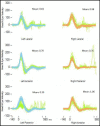Vestibulo-Ocular Reflex Abnormalities in Posterior Semicircular Canal Benign Paroxysmal Positional Vertigo: A Pilot Study
- PMID: 28955674
- PMCID: PMC5610375
Vestibulo-Ocular Reflex Abnormalities in Posterior Semicircular Canal Benign Paroxysmal Positional Vertigo: A Pilot Study
Abstract
Introduction: Benign paroxysmal positional vertigo (BPPV), involving the semicircular canals, is one of the most common diseases of the inner ear. The video head impulse test (vHIT) is a new test that examines the function of the canals. This study aimed to investigate the vestibulo-ocular reflex (VOR) gain, gain asymmetry and saccades after stimulating all six canals in patients definitively diagnosed with posterior semicircular canal BPPV (PSC-BPPV).
Materials and methods: Twenty-nine unilateral PSC-BPPV patients with normal oculographic and caloric results were enrolled in this study. vHIT was performed on six canals, and VOR gain, gain asymmetry and saccades were measured.
Results: Sixteen (55.17%) patients had abnormal posterior canal VOR gains in the ipsilesional ear. VOR gains in both horizontal canals were within normal limits. Superior canal VOR gains were mostly lower than normal and were not correlated to PSC abnormalities (P>0.05). No corrective saccades could be observed.
Conclusion: VOR gain in the direction of the posterior semicircular canal may be reduced in PSC-BPPV patients. Evaluation of PSC-VOR parameters could be beneficial, although superior canal measurements should be interpreted with caution.
Keywords: Benign paroxysmal positional vertigo; Head impulse test; Semicircular canals; Vestibulo-ocular reflex.
Figures

Similar articles
-
Assessment of semicircular canal function in benign paroxysmal positional vertigo using the video head impulse test and caloric test.Laryngoscope Investig Otolaryngol. 2023 Feb 3;8(2):525-531. doi: 10.1002/lio2.1020. eCollection 2023 Apr. Laryngoscope Investig Otolaryngol. 2023. PMID: 37090879 Free PMC article.
-
Video head impulse testing in patients with benign paroxysmal positional vertigo.Acta Otolaryngol. 2020 Dec;140(12):977-981. doi: 10.1080/00016489.2020.1805123. Epub 2020 Aug 17. Acta Otolaryngol. 2020. PMID: 32804587
-
Feasibility of Using the Video-Head Impulse Test to Detect the Involved Canal in Benign Paroxysmal Positional Vertigo Presenting With Positional Downbeat Nystagmus.Front Neurol. 2020 Oct 15;11:578588. doi: 10.3389/fneur.2020.578588. eCollection 2020. Front Neurol. 2020. PMID: 33178119 Free PMC article.
-
Clinical significance of video head impulse test in benign paroxysmal positional vertigo: a meta-analysis.Eur Arch Otorhinolaryngol. 2021 Dec;278(12):4645-4651. doi: 10.1007/s00405-021-06832-3. Epub 2021 Apr 27. Eur Arch Otorhinolaryngol. 2021. PMID: 33907856 Review.
-
Video head impulse test: a review of the literature.Eur Arch Otorhinolaryngol. 2017 Mar;274(3):1215-1222. doi: 10.1007/s00405-016-4157-4. Epub 2016 Jun 21. Eur Arch Otorhinolaryngol. 2017. PMID: 27328962 Review.
Cited by
-
The Video Head Impulse Test in the acute stage of posterior canal benign paroxysmal positional vertigo.Acta Otorhinolaryngol Ital. 2021 Feb;41(1):69-76. doi: 10.14639/0392-100X-N1033. Acta Otorhinolaryngol Ital. 2021. PMID: 33746225 Free PMC article.
-
Video Head Impulse Test Findings in Patients With Benign Paroxysmal Positional Vertigo Secondary to Idiopathic Sudden Sensorineural Hearing Loss.Front Neurol. 2022 Jun 2;13:877777. doi: 10.3389/fneur.2022.877777. eCollection 2022. Front Neurol. 2022. PMID: 35720082 Free PMC article.
-
Assessment of semicircular canal function in benign paroxysmal positional vertigo using the video head impulse test and caloric test.Laryngoscope Investig Otolaryngol. 2023 Feb 3;8(2):525-531. doi: 10.1002/lio2.1020. eCollection 2023 Apr. Laryngoscope Investig Otolaryngol. 2023. PMID: 37090879 Free PMC article.
-
Disability and Anxiety in Vestibular Diseases: A Cross-Sectional Study.Cureus. 2020 Nov 30;12(11):e11813. doi: 10.7759/cureus.11813. Cureus. 2020. PMID: 33409058 Free PMC article.
-
Prevalence of Vestibular Disorders in Independent People Over 50 That Experience Dizziness.Front Neurol. 2021 May 20;12:658053. doi: 10.3389/fneur.2021.658053. eCollection 2021. Front Neurol. 2021. PMID: 34093406 Free PMC article.
References
-
- Kim JS, Zee DS. Benign Paroxysmal Positional Vertigo. N Engl J Med. 2014;370(12):1138–47. - PubMed
-
- Arshad M, Abbas S, Qureshi IA. Delay in diagnosis and treatment of benign paroxysmal positional vertigo in current practice. J Ayub Med Coll Abbottabad. 2013;25(1–2):93–5. - PubMed
-
- Strupp M, Brandt T. Peripheral vestibular disorders. Curr Opin Neurol. 2013;26:81–9. - PubMed
-
- Perez-Fernandez N, Martinez-Lopez M, Manrique-Huarte R. Vestibulo-ocular reflex in patients with superior semicircular canal benign paroxysmal positional vertigo (BPPV) Acta Otolaryngol. 2014;134(5):485–90. - PubMed
-
- Faralli M, Manzari L, Panichi R, Botti F, Ricci G, Longari F, et al. Subjective visual vertical before and after treatment of a BPPV episode. Auris Nasus Larynx. 2011;38(3):307. - PubMed
LinkOut - more resources
Full Text Sources
